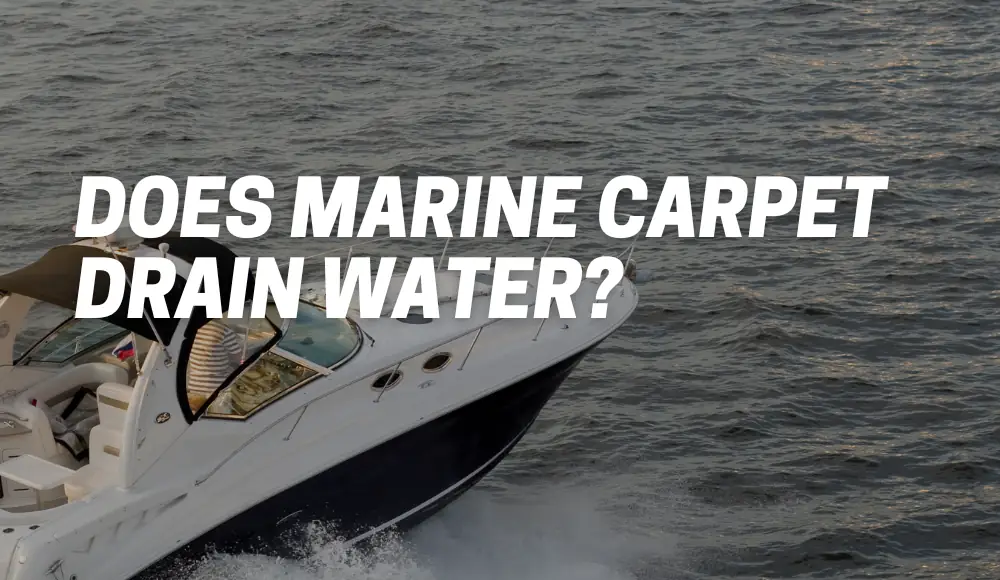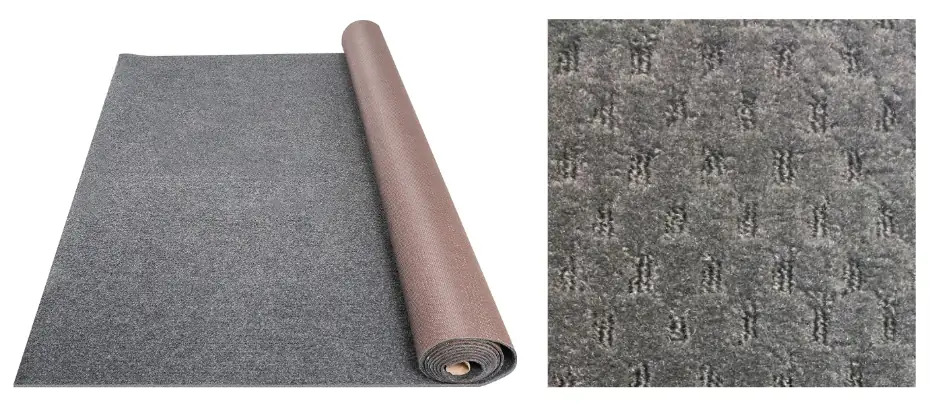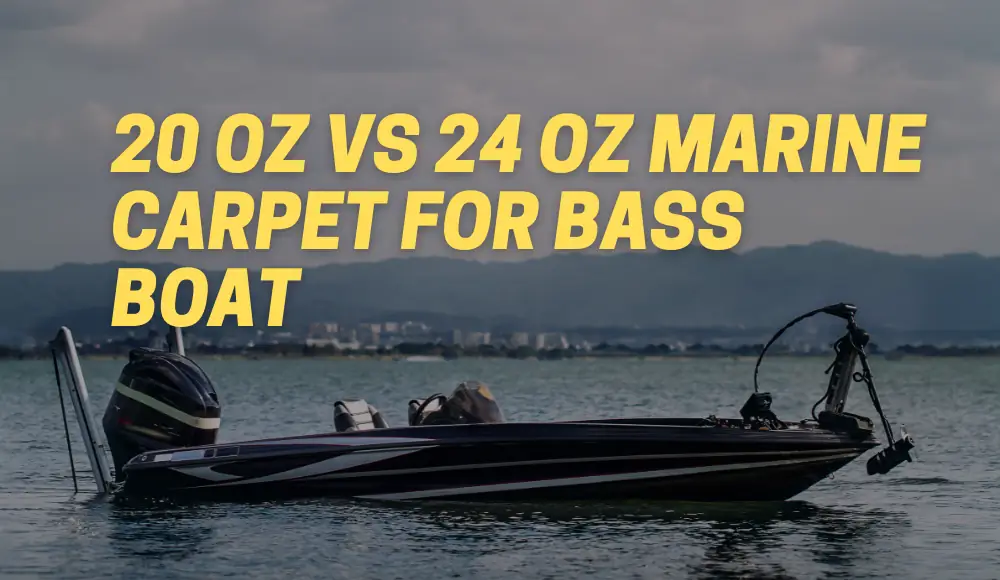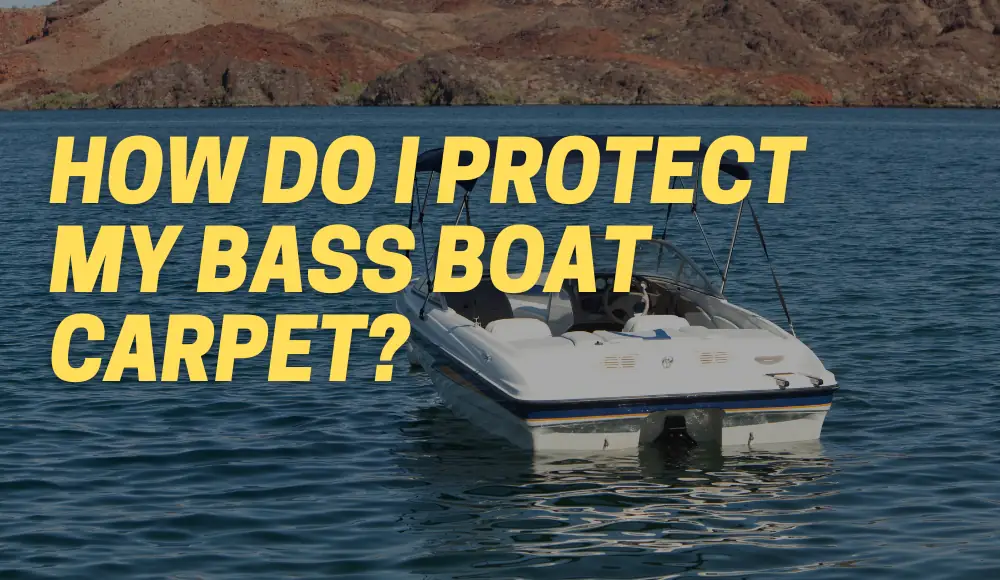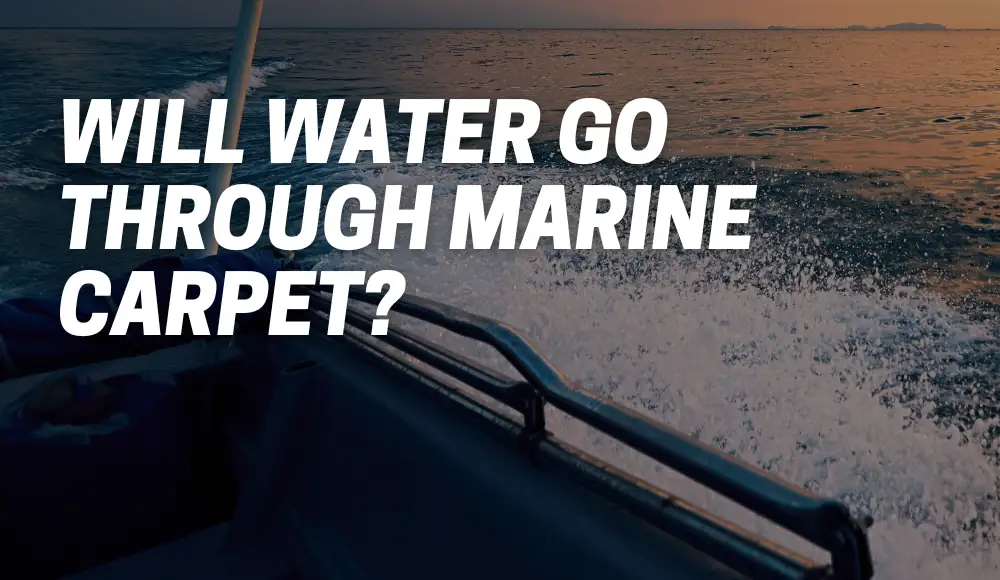If you’re a boat owner, you know the importance of having reliable and durable flooring that can withstand the harsh marine environment. One popular option for boat flooring is marine carpet. But you may be wondering, does marine carpet drain water?
In this article, we will dive into the world of marine carpet and explore its drainage capabilities, along with other important considerations when choosing the right flooring for your boat.
How Marine Carpet Works
Marine carpets are specifically designed to handle the unique conditions of being on a boat. The structure of marine carpet is made up of synthetic fibers, which are woven together to form a tight, dense surface.
This means that the carpet can withstand heavy foot traffic and constant exposure to water without degrading or deteriorating.
Another key feature of marine carpet is its backing material. Typically, marine carpet has a rubber or vinyl backing that provides extra cushioning and helps prevent slipping on wet surfaces.
This backing is also designed to allow water to flow through it, ensuring that the carpet stays dry and mold-free. The materials used in marine carpet are carefully chosen for their water-resistant properties.
Common materials include olefin, polyester, and polypropylene, all of which are known for their durability and resistance to moisture. These materials are also often treated with special coatings or finishes that provide additional protection against stains and UV damage.
Overall, marine carpet is an extremely versatile flooring option that can withstand the harshest conditions on the water. Its unique design elements make it an ideal choice for any boat owner who wants a durable, comfortable surface that will not deteriorate over time.
Drainage Mechanisms in Marine Carpet
The Importance of Drainage in Marine Carpet
Marine carpet is designed to withstand harsh marine environments, but it’s not immune to the effects of water exposure. Standing water can lead to mold, mildew, and other issues that can compromise the health of your boat. That’s why proper drainage is essential.
Backing Materials for Drainage
One way marine carpet drains water is through its backing materials. Some marine carpets are backed with materials like rubber or PVC foam that allow water to circulate freely underneath the surface. This helps prevent the buildup of moisture that can lead to mold and mildew.
Perforations for Drainage
Another common mechanism for draining water in marine carpet is through perforations in the surface. These small holes allow water to seep through and drain away from the surface quickly. The size and frequency of these perforations can vary depending on the manufacturer, but they all serve a similar purpose; keeping your boat environment dry and healthy.
The Benefits of Good Drainage Mechanisms
When your marine carpet has effective drainage mechanisms, it helps keep your boat clean and dry. You’ll be less likely to experience issues like foul odors or damage from standing water. Plus, you’ll be able to enjoy your time on the water without worrying about slipping on a wet surface or dealing with excess moisture.
Overall, understanding how different types of marine carpets drain water will help you make an informed decision when choosing a product for your boat. Whether you opt for a backing material that promotes circulation or rely on perforations in the surface for drainage, make sure you prioritize proper drainage as part of your overall maintenance routine.
Does Marine Carpet Hold Water?
Marine carpet is designed to be water-resistant, but it does have some capacity to hold water.
Unlike traditional household carpets that absorb moisture, marine carpet is typically made from specialized materials that repel water to some extent. This feature helps to prevent excessive water absorption and allows for better drainage.
While marine carpet may retain a small amount of water on its surface, it is designed with drainage channels or perforations that enable water to flow through the carpet, preventing pooling and promoting faster evaporation.
These drainage channels are essential for maintaining a dry and safe boating environment.
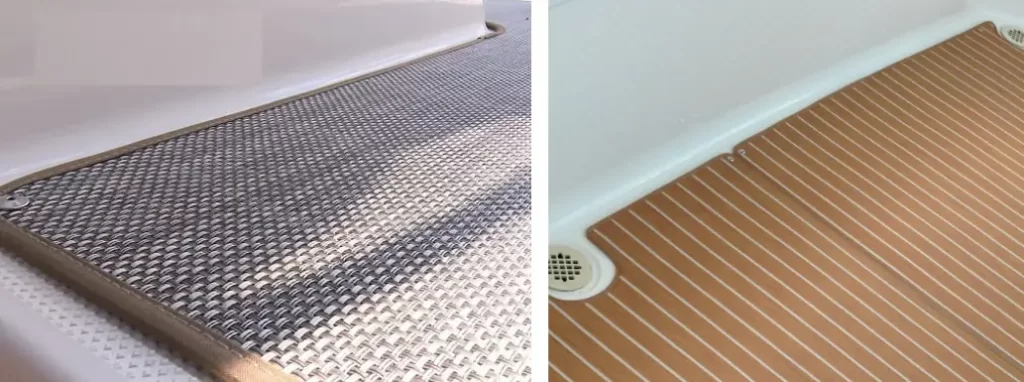
Factors Affecting Drainage Performance
The Importance of Proper Installation
The way your marine carpet is installed can have a significant impact on its drainage performance.
It’s essential to ensure that the carpet is stretched and secured correctly, with no wrinkles or lumps that could impede water flow. Be sure to choose an installer who has experience with marine carpet installation and can guarantee proper installation techniques.
The Effect of Foot Traffic
Foot traffic puts a lot of weight on your marine carpet, which can compress the fibers and hinder drainage over time.
If you frequently have passengers or guests onboard, you may want to consider adding additional supports under high-traffic areas, such as walkways or steps. Alternatively, choose a type of carpet specifically designed for high-foot-traffic areas.
Cleaning Frequency
Regular cleaning is crucial for maintaining optimal drainage performance in your marine carpet. Dirt, debris, and other materials can accumulate over time and clog up the perforations or backing material that allow water to flow through.
Make sure to clean your marine carpet regularly using mild detergents and a soft brush, paying special attention to areas where water tends to pool.
Maximizing Drainage Efficiency
To get the most out of your marine carpet’s drainage capabilities:
- Choose a style with larger perforations or better backing material if you’re concerned about drainage efficiency.
- Avoid heavy foot traffic in areas with shallow draining carpets.
- If possible, elevate carpets away from direct contact with wet surfaces.
- If you’re replacing existing marine flooring because it isn’t draining properly, consider adding more drains or changing up the layout.
By following these tips and taking care to maintain your marine carpet properly, you’ll be able to enjoy its full benefits for years to come.
Maintenance Tips to Ensure Proper Drainage
Keep Your Marine Carpet Clean and Free of Debris
To ensure that your marine carpet drains water effectively, it’s important to keep it clean and free of debris. Regular cleaning is key to preventing the buildup of dirt, sand, and other particles that can clog the carpet’s drainage mechanism.
If you allow these materials to accumulate over time, they can impede water flow and cause your carpet to become waterlogged.
To prevent this from happening, make sure you vacuum your marine carpet frequently and remove any loose debris by hand.
You should also consider investing in a high-powered pressure washer to blast away stubborn dirt and sand. Just be careful not to use too much pressure, as this could damage the surface fibers of your carpet.
Emphasize the Importance of Regular Cleaning
In addition to keeping your marine carpet clean and free of debris, it’s crucial that you perform regular deep cleaning as well. This means using a specialized marine carpet cleaner that can penetrate deep into the fibers of your carpet while also removing any stubborn stains or odors.
When selecting a cleaner, be sure to choose one that’s specifically designed for use on marine carpets. Avoid using household cleaners or harsh detergents, as these can damage the delicate fibers of your carpet or leave behind a sticky residue that impedes drainage.
By following these maintenance tips for marine carpets, you’ll ensure that yours drains water effectively while also maintaining optimal performance over time. With proper care and attention, your boat will remain dry and comfortable no matter how rough the seas get.
How Long Does Marine Carpet Take to Dry?
The drying time for marine carpet can vary depending on various factors such as the carpet’s thickness, the prevailing weather conditions, and the amount of water exposure.
Generally, marine carpet is designed to dry relatively quickly, thanks to its water-repellent properties and efficient drainage system.
In ideal conditions, marine carpet can dry within a few hours to a day. However, if the carpet is heavily saturated or the weather is humid, it may take slightly longer for it to completely dry.
It’s important to allow sufficient time for the carpet to dry thoroughly before storing or covering it to prevent mold or mildew growth.
What Are the Pros and Cons of Marine Carpet?
Like any product, marine carpet has its own set of advantages and disadvantages. Let’s take a closer look at some of them:
Pros of Marine Carpet:
- Comfortable and Soft: Marine carpet provides a cushioned and comfortable surface, making your boating experience more enjoyable.
- Slip-Resistant: The textured surface of marine carpet enhances traction and helps prevent slips and falls, even when the deck is wet.
- Noise Reduction: Marine carpet can reduce noise levels on your boat, creating a quieter and more pleasant environment.
- Insulation: The carpet acts as insulation, keeping the boat’s interior warmer during cooler months.
- Easy Installation: Marine carpet is relatively easy to install and can be customized to fit the contours of your boat’s floor.
Cons of Marine Carpet:
- Water Retention: While marine carpet is designed to drain water efficiently, it can still retain some moisture, which may require additional drying time.
- Stains and Odors: If not properly maintained, marine carpet can become susceptible to stains and odors, requiring regular cleaning and care.
- Fading and Wear: Continuous exposure to sunlight and foot traffic can cause marine carpet to fade and wear over time, requiring periodic replacement or refurbishment.
Does Marine Carpet Rot?
One common concern boat owners have is whether marine carpet is prone to rotting.
Rot is typically associated with organic materials that decay when exposed to moisture and air. However, marine carpet is specially manufactured to resist rotting.
Marine carpet is typically made from synthetic materials such as polypropylene or polyester, which are highly resistant to mold, mildew, and rot. These materials are specifically chosen to withstand the challenging marine environment and maintain their structural integrity over time.
To ensure the longevity of your marine carpet, it’s important to practice proper maintenance, including regular cleaning, drying, and inspecting for any signs of wear or damage.
By following these guidelines, you can significantly prolong the life of your marine carpet and prevent potential issues.
Carpets for boats
Frequently Asked Questions
What is the best carpet to use for a boat floor?
Marine carpet is generally considered the best option for boat flooring due to its water-resistant properties, slip resistance, and comfort.
However, other alternatives like vinyl flooring, SeaDek flooring, or synthetic teak decking can also be viable choices depending on personal preferences and budget.
What is better than carpet in a boat?
If you prefer a non-carpet flooring option, there are alternatives available.
As already mentioned, vinyl flooring, synthetic teak decking, or rubber flooring are popular choices that offer durability, easy maintenance, and a sleek appearance for your boat.
How long does marine carpet last?
The lifespan of marine carpet can vary depending on factors such as the quality of the carpet, usage patterns, and maintenance practices. On average, marine carpet can last between 5 to 10 years, but with proper care, it can exceed this timeframe.
Can you vacuum marine carpet?
Yes, you can vacuum marine carpet to remove loose dirt, debris, and particles. However, it’s important to use a vacuum cleaner with adjustable suction power and avoid aggressive brushing to prevent damage to the carpet fibers.
Conclusion
Marine carpet is a popular and reliable choice for boat flooring due to its water-resistant properties and efficient drainage system.
While it may retain some water, marine carpet is designed to dry relatively quickly. Understanding the pros and cons of marine carpet can help you make an informed decision when selecting the best flooring option for your boat.
Remember to prioritize proper maintenance to ensure the longevity and performance of your marine carpet, allowing you to enjoy your boating adventures for years to come.
List of Useful Information:
- Marine carpet is water-resistant and features drainage channels or perforations for efficient water flow.
- Drying time for marine carpet varies but generally takes a few hours to a day.
- Pros of marine carpet include comfort, slip resistance, noise reduction, insulation, and easy installation.
- Cons of marine carpet include water retention, susceptibility to stains and odors, and fading and wear.
- Marine carpet is specially manufactured to resist rotting, thanks to synthetic materials like polypropylene or polyester.
- Alternatives to marine carpet for boat flooring include vinyl flooring, synthetic teak decking, and rubber flooring.
- Proper maintenance, including regular cleaning and drying, can extend the lifespan of marine carpet.
- Vacuuming is suitable for marine carpet, but gentle cleaning methods are recommended.
